
As you may recall, Amanda and I are heading to Sweden this month, and in honor of the trip, I broke out this book from the late 1940s my mom gave me for Christmas.
The thing that made this interesting for me to try was the fact that you’re supposed to make the cheese for this cheese cake. Ost: cheese. Kaka: cake. Ostkaka: Cheese cake!
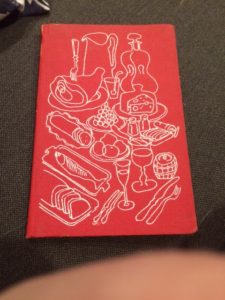
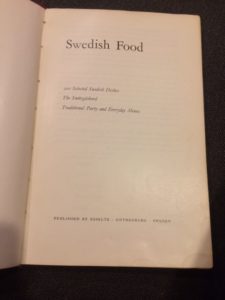
Cheese is fun! Cheese is FINICKY. As I said on Twitter, either this was going to be a post on ostkaka, or it was going to be a post on how to screw up cheese.
It’s kind of both.
First, the recipe (I cut it in half because…oof that’s a lot):
10 quarts milk
2/3 cup flour
3 household rennet tablets
8 eggs
1/2 cup sugar, scant
1 pint heavy cream
1/2 cup blanched almonds, chopped
Dissolve rennet tablets in 3 tablespoons cold water. Mix flour with milk while stirring and heat until warm. Add dissolved rennet tablets and stir for a few seconds. Pour into strainer lined with cheesecloth and press out as much whey as possible. Add egg, sugar, almonds, cream, and stir until well blended. Pour into a buttered casserole and bake in a slow oven (250 F) 45 minutes, or until set and light brown. Serve with jam.
As you can see, this is a bit lacking in detail. And the instructions for making the curds kind of assumes a level of previous knowledge that I have some of, and maybe people the book was aimed at had, but a lot of people now don’t.
For example, “household rennet tablets?” My grocery store doesn’t carry that. I got my rennet from Amazon, but I have NO idea how similar it is in size to a midcentury household rennet tablet.
Also we have the problem of how milk is processed. Yes, in the 1940s, milk was pasteurized, but a lot of the mass-produced dairy products now are either ultra-pasteurized or High Temp Short Time pasteurized. Ultra-pasteurization heats the milk to 220 degrees for a few seconds, then cools it down rapidly. It makes milk unusable for cheese making. High Temp Short Time pasteurization, which heats the milk to 161 degrees for 15 seconds is…. less useful for making cheese. Regular pasteurization, which brings the milk up to 145 degrees for 30 minutes, is what the cheesemaker wants.
What the heat treatment does is it alters the proteins in the milk. Ultra Pasteurized milk won’t curdle at all, while HTST milk will half-assedly curdle. Yes, it’s possible to get pasteurized milk, but it’s considerably more expensive (and when you’re supposed to get 5 quarts REALLY adds up) and requires a trip to the hippie grocery store or the Boston Public Market. I took a chance that the grocery store milk labeled “Pasteurized” would work – I’ve had good results making fresh mozzarella from Garelick Farms milk before – but it didn’t totally work this time. I got half-assed curds.
(Yes, there are sources for raw milk, but all of the sources in Massachusetts require a car to get them. And they are expensive.)
ANYWAY, here we go (for the cheesemaking parts, I modified the instructions from cheesemaking.com for basic fresh mozz):
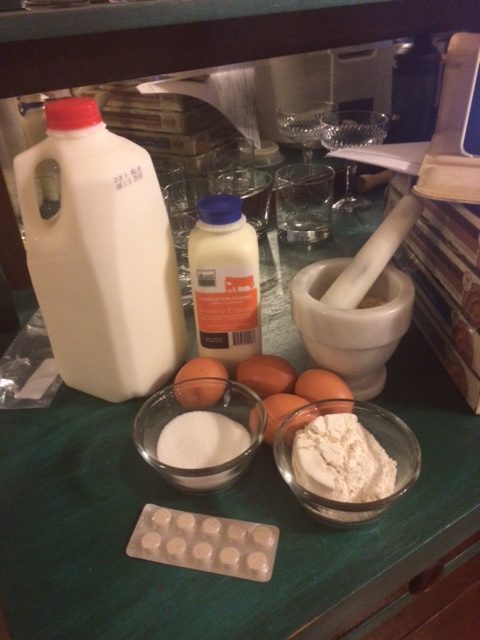
While boiling the cheesemaking equipment wasn’t really necessary here (you do that to keep rando bacteria from infecting your cheese, and in this particular case, the baking would kill anything off) it’s still a good habit to keep. So I boiled the pot and the thermometer.
Milk in pot, add flour. I really don’t know what effect the flour had on the curdling process. Heat the milk to 90 degrees (per cheesemaking.com) and add in the dissolved rennet tablets. The mozz instructions required 1/4 rennet tablet dissolved in water, this called for 3 tablets….I tossed in two but they didn’t dissolve all the way, so call it 1.5 tablets. Really, 1/4 tablet should have done it, but hey.
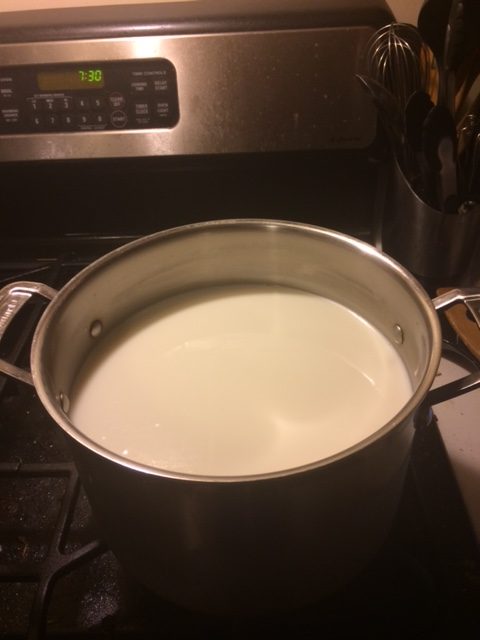
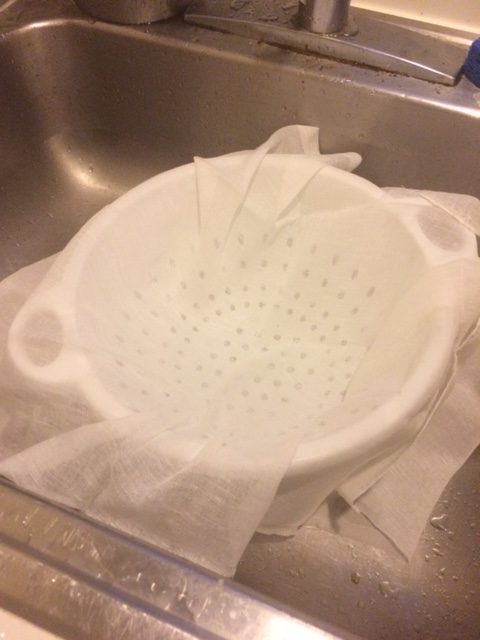
Anyway, turn off the heat, toss in the rennet, stir it for 30 seconds, then let it sit covered for for 5 minutes. At this point you pull off the cover and pray.
What it SHOULD do is jiggle like a fairly solid mass so you can cut the curds. As you can see, this did not set quite enough.
I decided to see what I could do with the half-ass curds, and drained them.
They were okay, but pretty mushy and there was just not enough of them.
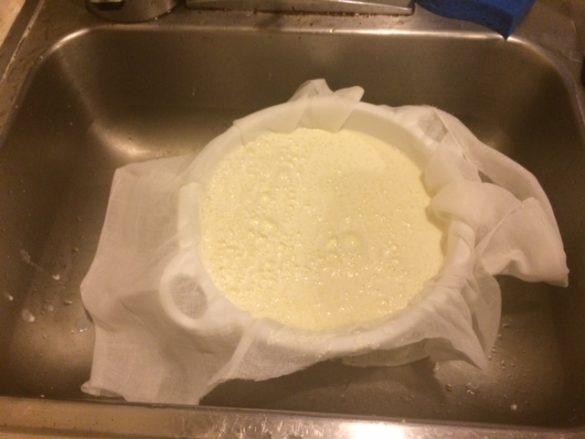
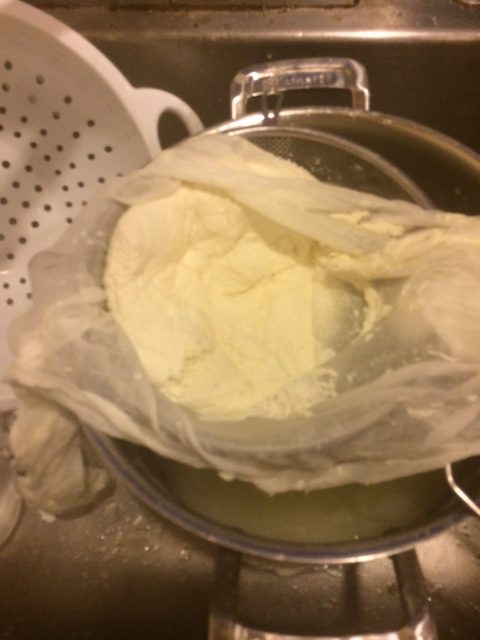
Once the curds are drained, then you put the curds in a bowls with the almonds, sugar, cream, and eggs. I had NO idea what kind of consistency we were looking for, and I should have not used as many eggs as it called for.
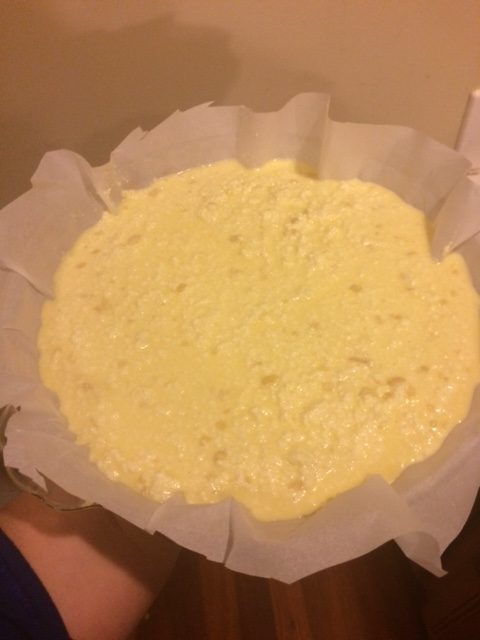
Oven: 250F.
Time: ultimately about an hour and a half. It was just way too wet.
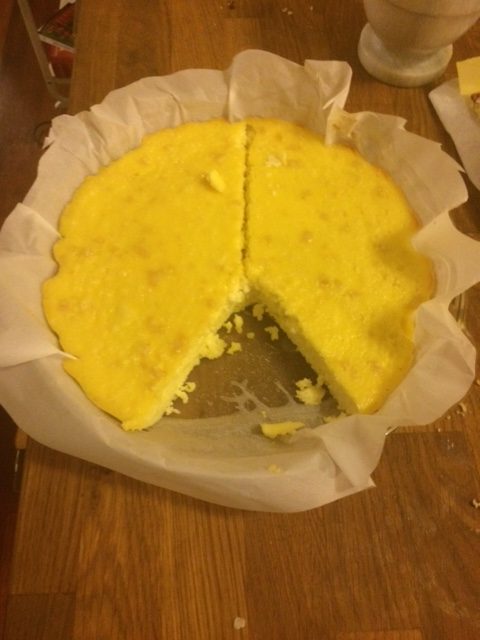
Verdict: It was tasty, if eggy. And the almonds gave it a nice flavor, and it went well with lingonberry jam. But I can totally see why modern ostkaka recipes use drained cottage cheese – it’s far more precise for cooks who aren’t experienced in cheesemaking.
I was chatting with a friend of mine in Sweden who said that there was an ostkaka contest happening in Halsingland last weekend. I will have to hunt some down and see how far off I was!


Here is a place in Stockholm that serves ostkaka. The restaurant is at Skansen, an outdoor museum in Stockholm with old buildings from all over Sweden and a small zoo, a popular destination for both us in Stockholm as tourists.
http://www.skansensrestauranger.se/restauranger-stockholm/restaurang-solliden/sollidens-smorgasbord/
OMG ostkaka! I haven’t eaten that since I went vegan sixteen years ago. My gran, who used to make a fabulous ostkaka, would always add a bitter almond with the normal almonds. And whenever I go home to visit my parents (in Sweden) they always eat ostkaka with cloudberry- or raspberry jam, rather than lingon.
Looking forward to your trip to Sweden!
I’ve never made (or eaten) ostkaka, but I have made cheese – both fresh cheese (e.g. paneer) and ripened cheese (e.g. cheddar) – and I have never seen a cheese recipe that calls for flour to be added to the milk! Maybe it was to help the cheese thicken or the cake set – makes more sense that it would be for the cake as it wouldn’t thicken the cheese since the milk isn’t heated hot enough.
The best cheese I made was with some milk given to me fresh from the cow (it is illegal to sell raw or unpasturized milk here in Canada so I was gifted with the milk and in return gave 1/4 of the cheese wheel to the person who gave me the milk). Again, I don’t know the rules in the US but here, Ultra-Pasturized or HTST milk must be labeled and anything else is regular-pasturized; prices are comparable between them. One trick for creamier cheese is to replace 1/4 cup of the milk with 1/4 cup of whipping cream – essentially de-homogonizing the milk!
Somehow it never occurred to me to make cheese at home, which is strange given that my official cooking mantra is basically: how can I make this more complicated and time consuming. I… I’m predicting a lost weekend. This was yet another inspiring kitchen post. Thanks?
@kkw: you’re welcome?
I highly, HIGHLY recommend cheesemaking.com for tips, tricks, and they sell starter kits that have everything you need for starting out. THEN, you can branch out and start getting mold cultures and buy a mini fridge to serve as a cheese cave and build your own cheese press…
They also keep a list for good milk producers in each state.
I AM THE WORST. I sent the link to this post to my family, and my aunt reminded me that SHE was the one who gave me that book, not my mother.
I AM THE WORST NIECE.
In the Uk the problem with cheese making with bought milk seems to be the homogenisation of milk. You can make things like paneet with it, but you have to use far more lemon juice or vinegar than you did before all supermarket milk was homogenised. I have had success with using ‘gold top’ when I can get it as that isn’t homeogenised so it has the layer of cream at the top the way the milk of my childhood did.
I did make hard cheese, a cheshire style, with a friend who had her own cows at the time (since sold as they just weren’t economic) and the difference using fresh untreated milk was enormous.
If you are curious,You can buy ostkaka in the grocery store. It is made by Frödinge from a traditional recipe.
Which reminds me: When are you coming to Sweden? ( Hopefully not next week since I am going to the US)